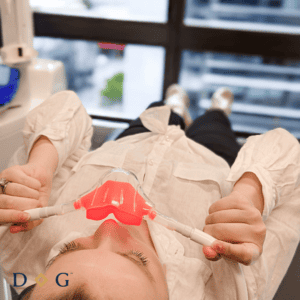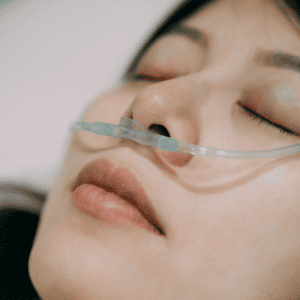Dental visits can be anxiety-inducing for many people, but thanks to advances in modern dentistry, sedation options can help make the experience more comfortable. Whether you’re undergoing a routine cleaning or a more complex procedure, understanding the different types of dental sedation and their benefits can make a big difference. In this blog, we’ll explore the various forms of dental sedation, how they work, and what you can expect from each.
What is Dental Sedation?
Dental sedation involves the use of medication to help patients relax during dental procedures. It’s particularly useful for those who experience dental anxiety, have a low pain threshold, bad gag reflex or require a lengthy or complex procedure. Sedation can range from mild relaxation to deep sleep, depending on the type used and the patient’s needs.

Types of Dental Sedation
Here at Dentistry On George, we are currently able to offer inhalation sedation and oral sedation. Intravenous sedation is coming soon in early 2025!
Inhalation Sedation (Laughing Gas)
Inhalation sedation uses nitrous oxide, commonly known as laughing gas, and is one of the most popular forms of sedation. Administered through a mask placed over the nose, nitrous oxide helps patients feel relaxed and at ease. Its effects are quick and short-lived, meaning you’ll be alert and able to respond to questions or instructions during the procedure. After the procedure, the effects wear off rapidly, allowing you to resume normal activities almost immediately.
Benefits: The effects are rapid and reversible, allowing patients to recover quickly once the gas is turned off. It’s a good option for those with mild to moderate anxiety.
Considerations: The gas must be inhaled through the nose. This will not suit those with nasal congestion, or claustrophobia who cannot tolerate the mask.

Oral Sedation
Oral sedation involves taking a sedative medication before your appointment. The medication helps you feel calm and relaxed, and you may feel drowsy but still be conscious. It’s important to have someone accompany you to and from the appointment, as the effects of oral sedation can linger for several hours.
Benefits: It’s easy to administer and doesn’t require needles or specialised equipment.
Considerations: The level of sedation cannot be altered. This is a one-time medication, and the results will vary from person to person. Patients may feel groggy or drowsy for several hours after the procedure, so arranging for a ride home is necessary.
IV Sedation
Intravenous (IV) sedation delivers medication directly into your bloodstream through a small cannula inserted into a vein. You might have heard this referred to as ‘twilight sedation’. This method allows for precise control over the level of sedation and can induce a deeper level of relaxation or sleep. With IV sedation, you might not remember much of the procedure afterward. Since this type of sedation requires more monitoring, it’s usually administered by a specialist or a trained dental sedationist.
Benefits: It provides a deeper level of relaxation and levels of sedation can be adjusted during the procedure. Patients may not remember much of the procedure afterward.
Considerations: IV sedation requires monitoring by a trained professional, and patients need someone to drive them home post-procedure.

Benefits of Conscious Sedation
Reduced Anxiety: Conscious sedation helps alleviate fear and nervousness, making dental visits more manageable for anxious patients.
Enhanced Comfort: By minimising discomfort and pain, sedation allows patients to undergo necessary treatments more comfortably.
Increased Cooperation: For patients with special needs or young children, sedation can help ensure they remain still and cooperative during the procedure.
Quick Recovery: Compared to general anesthesia, recovery from conscious sedation is generally faster, and patients can often resume normal activities more quickly.
Considerations and Safety
Medical History: Your dentist will review your medical history and any medications you are taking to ensure sedation is safe for you. Certain medical conditions or medications may affect how you respond to sedation.
Preparation: Depending on the type of sedation used, you may need to follow specific pre-procedure instructions, such as fasting or arranging transportation.
Post-Procedure Care: After sedation, it’s important to follow your dentist’s instructions regarding rest and aftercare. Avoiding driving or operating heavy machinery is generally advised.

Alternative Options
Conscious sedation does not suit everyone. It is not suitable for those with severe dental phobia or those with certain medical conditions. As an alternative, we can refer for general anesthesia.
General anesthesia is used for more invasive procedures or for patients with severe dental anxiety or specific medical conditions. It puts you into a deep sleep where you are completely unconscious and unaware of the procedure. General anesthesia is usually administered in hospital by an anaesthetist.
Conclusion
Conscious sedation offers a valuable option for patients who need help managing anxiety and discomfort during dental procedures while staying awake and responsive. By understanding the different methods and benefits of conscious sedation, you can discuss your options with your dentist to determine the best approach for your needs. Whether you’re undergoing a routine cleaning or a more complex procedure, conscious sedation can help make your dental experience more comfortable and less stressful.
You can arrange a dental consultation with our dentists to determine your suitability for dental sedation. If you are a new patient, you can book a new patient consultation and examination.



